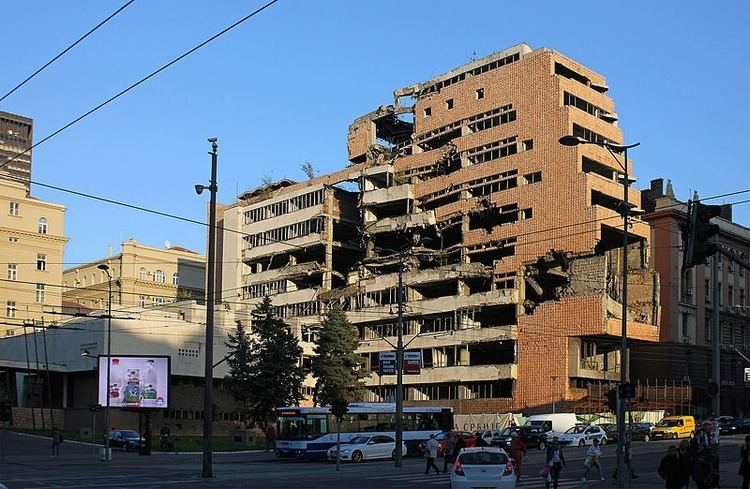Status Damaged / disused Floor area 49,235 m Completed 1965 Architect Nikola Dobrović | Closed 1999 Headquarters Belgrade, Serbia Construction started 1957 | |
 | ||
Type of business Government building for the Ministry of Defense Location Nemanjina Street, Belgrade, Serbia | ||
The Yugoslav Ministry of Defence building (Serbian: Savezni Sekretarijat za Narodnu Odbranu / Савезни секретариjaт за народну одбрану), also known as the Yugoslav General Staff (Serbian: Zgrada Generalštaba / Зграда Генералштаба) is a building that was previously occupied by the Ministry of Defense of Yugoslavia, a governmental department responsible for defending the Federal Republic of Yugoslavia from internal and external military threats.
Contents
Considered to be a masterpiece of post-war architecture, it was bombed during the NATO bombing of Yugoslavia in 1999.
History
The building was built between 1957 and 1965 and it was designed by Serbian architect, Nikola Dobrović. It is divided by Nemanjina Street, and its design is meant to resemble a canyon of the Sutjeska river, where one of the most significant battles of World War II in Yugoslavia was fought, with the street as a river dividing the two monumental, gradually completed tracts. As Nemanjina Street comes up the hill from the main railway station, the two parts of the building form a symbolic gate.
In addition to expressive cascading forms, facades are characterized by the application of contrasting materials - robust, brown-red stone from Kosjerić and white marble slabs from the island of Brač. The most striking visual motif representing the window bars on the facades, designed in the spirit of late modernism.
The first part of the building, standing across the Government of Serbia building in Kneza Miloša Street, is named Building "A" and has 12,654 square meters. The other part of the building, divided by Nemanjina Street, is named Building "B" and has 36,581 square meters.
1999 bombing
In the midnight of 29/30 April 1999, during the NATO bombing of Yugoslavia, because of military importance, the building was bombed two times in the interval of 15 minutes. It was bombed once again nine days later, in the midnight of 7/8 May 1999.
Post-bombing
Severely damaged by the 1999 bombing, the building has not been repaired for over a decade and is Belgrade’s most famous ruin. Since 2005, it has been the protected monument of culture, symbolizing the 1999 NATO bombing and "suffering of Serbia".
Building "B" was much less damaged during the bombings, and in the following years entrance of the building has been removed, for the safety of the pedestrians.
In November 2015, with the budget of 650,000 euros, the first phase of reconstruction of Building "A" has started, for the purpose of structure collapse prevention. By May 2016, the central part was entirely demolished and the pillars for the part of building close to the street were poured. Around 5,000 square meters was demolished.
In February 2017, the Government of Serbia has decided to demolish most of the Building "A" construction with the obligation to re-build it to its original appearance once the country has the funds. This sudden decision was explained with the high cost of the further reconstruction amounting to the estimated 7.66 million euros, while the demolition was estimated at 1.46 million euros. Minister of Defence of Serbia, Zoran Đorđević said that experts advocated for this solution despite already paid first phase of the reconstruction, while the military experts condemned this decision. On 9 March 2017, the Association of Serbian Architects launched an initiative for the submission of candidature for the UNESCO World Heritage Site, also saying that the Government of Serbia wanted to remove it from the register of cultural properties, but due to the long legal procedure resorted to the reconstruction. The Association condemned the decision and marked it as a "definitive loss of our culture" as it is a "monument of suffering and brutality of NATO forces".
Over the years, there have been talks that the building could be turned into a luxurious hotel of The Trump Organization. Following the reconstruction of Building "A" and later proposed demolition of the most of the construction, Prime Minister of Serbia Aleksandar Vučić, said that there are plans for the construction of Monument to Stefan Nemanja and Museum of medieval Serbia on the place of the Building "A".
